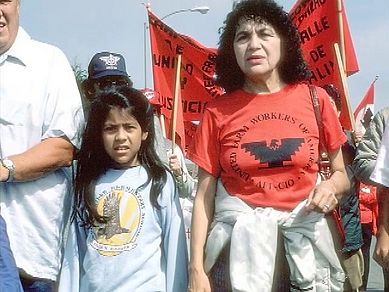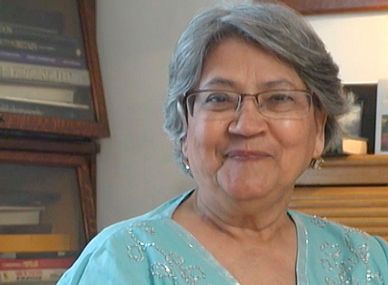Click! in the Classroom
Dolores Huerta: A Civil Rights Icon
Grade Level: Grades 6-12 | Estimated Time: One class period |
How did activist Dolores Huerta grapple with the dual roles of motherhood and total commitment to social justice and political change?
Excerpt from “A Crushing Love: Chicanas, Motherhood and Activism,” a film by Sylvia Morales. (Running time 4:37) Used with permission. The complete film is available from Women Make Movies.
Introduction
This lesson plan introduces students to the life and work of the labor leader and civil rights activist Dolores Huerta, who co-founded the United Farm Workers (originally called the National Farm Workers Association) with César Chávez in 1962. Since the 1960s, Huerta has been an activist for workers’ rights, women’s rights, and immigrant rights. In 2012, she received the Presidential Medal of Freedom from President Barack Obama.
Learning Objectives
Students will be able to demonstrate their understanding of women’s roles in the farm workers movement of the 1960s and 1970s.
Student will learn about the connections between different movements for social justice and workers’ rights.
Essential Questions
What motivates people to seek greater rights?
How are the struggles for workers’ rights related to struggles for other civil and legal rights?
What does it mean to call the United States a land of opportunity?
Materials
Computer with Speakers and Internet Access
Paper for Note Taking Assignment
This Lesson Plan (PDF)
KWL Chart (PDF)
Warm Up Activity: Film Viewing and Discussion
Show a clip from the film A Crushing Love: Chicanas, Motherhood, and Activism (4:37 min.), also located at the top of this lesson plan.
Ask students what they know about the 1960s and 1970s farm worker struggles or about César Chávez.
Transition to the Main Activity by telling the students they are going to be learning more about this subject through a focus on one of its greatest leaders, Dolores Huerta.
Main Activity: Research with Note Taking and Written Summary; Discussion
Divide the class into groups and have each group go to Click and look at the timeline on the home page.
Guide them to “1962: United Farm Workers” and have them click on the link to the Dolores Huerta Foundation. Guide them to the “About” tab (at the top of the page) and then to the “Dolores Huerta” tab, which provides a short biography of Huerta.
Have the students read the biography. They should take notes on a piece of paper to answer these guiding questions:
Why is the first section titled “The Feminist Seed is Planted”?
What were the farm worker activists’ specific goals? Specific achievements?
How and why did Huerta connect women’s rights to farm workers’ rights?
How has Huerta been honored for her work?
Have the students in each group discuss their findings about Dolores Huerta.
You could have them also discuss the film clip A Crushing Love, to focus their attention on the unique challenges of activist women and their children.
You can further direct their discussions by having them concentrate on and define specific words, including boycott, strike, union, labor, nonviolence, and feminism.
Have each group write a summary of their findings.
Have a member of each group share their summary with the class to open up class discussion.
Discussion can center on how their summaries are similar or different.
Ask students to voice questions they still have about Huerta and this activist history.
Alternatively, have students fill out a KWL Chart (PDF).
Students can return to Click to do more research and reading about Chicana feminism.
Guide them to the section “Separate Roads to Feminism” in the chapter “Politics and Social Movements.”
This section includes another clip from the film A Crushing Love (also located below) and links to further resources on Chicana feminism.
Have the students share what they have learned about Chicana feminism.
How did resilience, persistence and forgiveness guide Martha Cotera on the road to Chicana feminism?
Excerpt from “A Crushing Love: Chicanas, Motherhood and Activism,” a film by Sylvia Morales. (Running time 6:45) Used with permission. The complete film is available from Women Make Movies.
Extension Activity: Research and Discussion on Political Language
In 1972, Huerta coined the phrase Sí, se puede (“Yes, it can be done”) and it came into popular use during Chavez’s 24-day fast protesting a new Arizona law prohibiting boycotts and strikes by farm workers.
The phrase was re-translated by Obama during his 2008 campaign as “Yes, we can.”
Have students research and discuss the news media’s explanation of the origins and political use of the phrase. Ask them to focus on how many news stories discuss both Huerta and Chávez versus how many discuss only Chávez.
Common Core Anchor Standards
Reading
Key Ideas and Details:
CCSS.ELA-LITERACY.CCRA.R.2
Determine central ideas or themes of a text and analyze their development; summarize the key supporting details and ideas.
Writing
Research to Build and Present Knowledge:
CCSS.ELA-LITERACY.CCRA.W.9
Draw evidence from literary or informational texts to support analysis, reflection, and research.
Speaking and Listening
Comprehension and Collaboration:
CCSS.ELA-LITERACY.CCRA.SL.2
Integrate and evaluate information presented in diverse media and formats, including visually, quantitatively, and orally.
How to Navigate our Interactive Timeline
You will find unique content in each chapter’s timeline.
Place the cursor over the timeline to scroll up and down within the timeline itself. If you place the cursor anywhere else on the page, you can scroll up and down in the whole page – but the timeline won’t scroll.
To see what’s in the timeline beyond the top or bottom of the window, use the white “dragger” located on the right edge of the timeline. (It looks like a small white disk with an up-arrow and a down-arrow attached to it.) If you click on the dragger, you can move the whole timeline up or down, so you can see more of it. If the dragger won’t move any further, then you’ve reached one end of the timeline.
Click on one of the timeline entries and it will display a short description of the subject. It may also include an image, a video, or a link to more information within our website or on another website.
Our timelines are also available in our Resource Library in non-interactive format.
Timeline Legend
Yellow bars mark entries that appear in every chapter
This icon indicates a book
This icon indicates a film
1971 The Click! Moment
The idea of the “Click! moment” was coined by Jane O’Reilly. “The women in the group looked at her, looked at each other, and ... click! A moment of truth. The shock of recognition. Instant sisterhood... Those clicks are coming faster and faster. They were nearly audible last summer, which was a very angry summer for American women. Not redneck-angry from screaming because we are so frustrated and unfulfilled-angry, but clicking-things-into-place-angry, because we have suddenly and shockingly perceived the basic disorder in what has been believed to be the natural order of things.” Article, “The Housewife's Moment of Truth,” published in the first issue of Ms. Magazine and in New York Magazine. Republished in The Girl I Left Behind, by Jane O'Reilly (Macmillan, 1980). Jane O'Reilly papers, Schlesinger Library.



